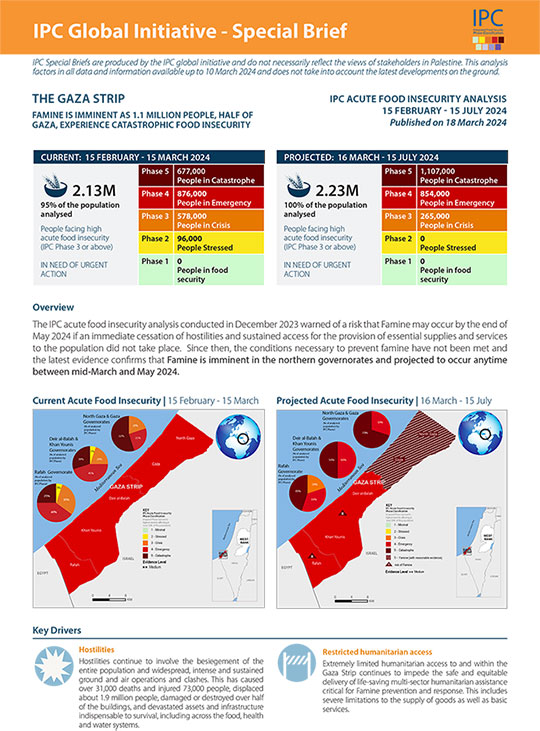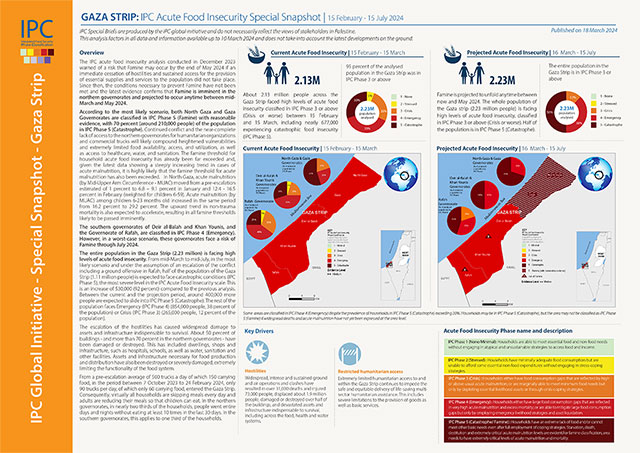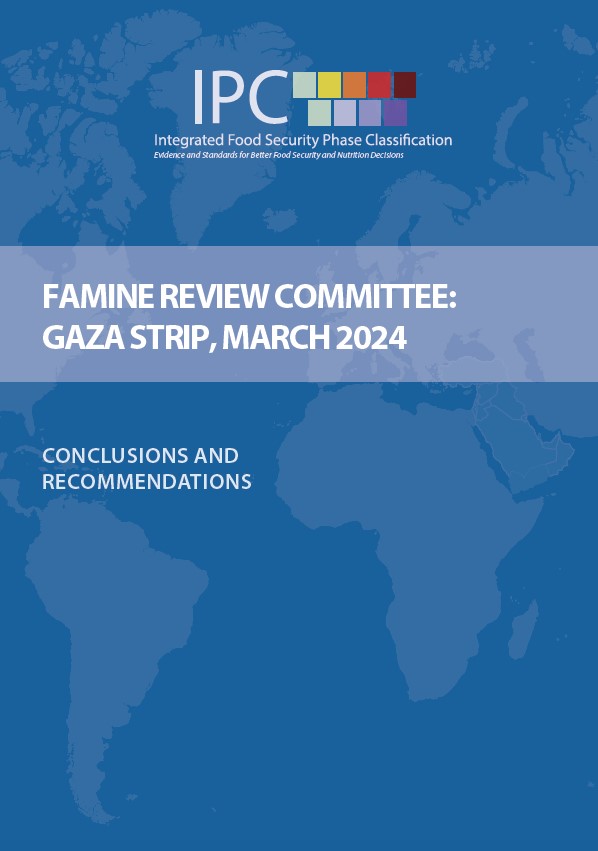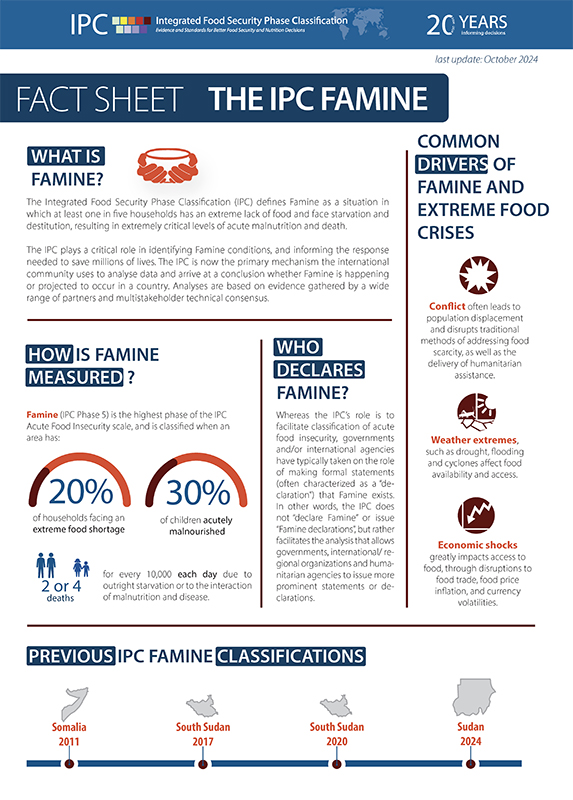WHO: Catastrophic Famine is ‘Imminent’ in Gaza
The latest analysis from the Integrated Food Security Phase Classification (IPC) partnership released today [March 18, 2024] warns that the situation in Gaza is catastrophic, with northern Gaza facing imminent famine and the rest of the Strip at risk as well.
"The IPC announcement reflects the dire situation that the people of Gaza are facing," said WHO (World Health Organization) Director-General Dr Tedros Adhanom Ghebreyesus. "Before this crisis, there was enough food in Gaza to feed the population. Malnutrition was a rare occurrence. Now, people are dying, and many more are sick. Over a million people are expected to face catastrophic hunger unless significantly more food is allowed to enter Gaza."
Before the recent months’ hostilities, 0.8% of children under 5 years of age were acutely malnourished. Today’s report shows that as of February in the northern governorates, that figure is between 12.4 and 16.5%.
Without a significant and immediate increase in deliveries of food, water and other essential supplies, conditions will continue deteriorating. Virtually all households are already skipping meals every day and adults are reducing their meals so that children can eat.
The current situation will have long-term effects on the lives and health of thousands. Right now, children are dying from the combined effects of malnutrition and disease. Malnutrition makes people more vulnerable to getting severely ill, experiencing slow recovery, or dying when they are infected with a disease. The long-term effects of malnutrition, low consumption of nutrient-rich foods, repeated infections, and lack of hygiene and sanitation services slow children’s overall growth. This compromises the health and well-being of an entire future generation.
WHO and partners have been carrying out high-risk missions to deliver medicines, fuel and food for health workers and their patients, but our requests to deliver supplies are often blocked or refused. Damaged roads and continuous fighting, including in and close to hospitals, mean deliveries are few and slow.
The IPC report confirms what we, our UN partners and nongovernmental organizations (NGOs) have been witnessing and reporting for months. When our missions reach hospitals, we meet exhausted and hungry health workers who ask us for food and water. We see patients trying to recover from life-saving surgeries and losses of limbs, or sick with cancer or diabetes, mothers who have just given birth, or newborn babies, all suffering from hunger and the diseases that stalk it.
WHO, as a partner of the Nutrition Cluster, is currently supporting a nutrition stabilization center in Rafah to treat children with severe acute malnutrition with medical complications, who are at the highest risk of imminent death if not urgently treated. We are supporting the establishment of two additional centres: one in the north of Gaza at Kamal Adwan hospital and one at the International Medical Corps field hospital in Rafah. WHO is supporting the pediatric wards of Al-Aqsa and Al-Najjar hospitals through the provision of nutrition supplies and medicines as well as training of medical personnel, and the promotion of appropriate infant and young child feeding practices, including breastfeeding.
WHO has trained health workers on how to recognize and treat malnutrition with complications. WHO is supporting hospitals and the centers with medical supplies for the children being treated.
Further nutrition and stabilization centres need to be added in all key hospitals in Gaza. Communities themselves will need the support to scale up the management of malnutrition locally.
WHO and other UN partners again ask Israel to open more crossings and accelerate the entry and delivery of water, food, medical supplies and other humanitarian aid into and within Gaza. As the occupying force, it is their responsibility under international law to allow for the passage of supplies including food. Recent efforts to deliver by air and sea are welcome, but only the expansion of land-crossings will enable large-scale deliveries to prevent famine. The time to act is now.
Notes
The Integrated Food Security Phase Classification (IPC) is a multi-partner initiative for improving food security and nutrition analysis and decision-making. By using the IPC classification and analytical approach, governments, UN Agencies, NGOs, civil society and other relevant actors, work together to determine the severity and magnitude of acute and chronic food insecurity, and acute malnutrition situations in a country, according to internationally recognized standards.
As a member of the IPC partnership, WHO provided technical expertise and information on the health situation for this evaluation. The conflict is posing extreme limitations to the ability to deliver life-saving health assistance to the population. In February 2024, attacks against health-care facilities, infrastructures and services continued, resulting in 58% of the hospitals not functioning in Gaza, especially in the Northern governorates (75% of the hospitals not functioning). According to the Health Cluster, as of 5 March 2024, only 2 hospitals and no Primary Health Care Centres were fully functioning. Acute respiratory infections and diarrheal diseases are rampant among children under five, exposing them to high-risk nutritional deterioration.
The full recommendations from the IPC
Famine can be halted—both in the immediate term and it requires urgent and proactive measures from parties to the conflict and the international community. They must immediately curb the rapidly escalating hunger crisis in the Gaza Strip, garner political support to put an end to the hostilities, mobilize necessary resources and ensure the safe delivery of humanitarian aid to the people of Gaza.
Overall recommendations
- Restore humanitarian access to the entire Gaza Strip.
- Stop the fast-paced deterioration of the food security, health and nutrition situation leading to excess mortality through: the restoration of health, nutrition, and WASH services and the protection of civilians; and the provision of safe, nutritious, and sufficient food to all the population in need.
- The sustained supply of sufficient aid commodities, including but not limited to food, medicines, specialist nutrition products, fuel, and other necessities should be allowed to enter and move throughout the entire Gaza Strip by road. Traffic of commercial goods should also be fully resumed to meet the volume of commodities required.
( Source: World Health Organization | Video: Al Jazeera's Victoria Gatenby )
GAZA STRIP: Famine is imminent as 1.1 million people, half of Gaza, experience catastrophic food insecurity
The IPC acute food insecurity analysis conducted in December 2023 warned of a risk that Famine may occur by the end of May 2024 if an immediate cessation of hostilities and sustained access for the provision of essential supplies and services to the population did not take place. Since then, the conditions necessary to prevent famine have not been met and the latest evidence confirms that Famine is imminent in the northern governorates and projected to occur anytime between mid-March and May 2024.
According to the most likely scenario, both North Gaza and Gaza Governorates are classified in IPC Phase 5 (Famine) with reasonable evidence, with 70% (around 210,000 people) of the population in IPC Phase 5 (Catastrophe). Continued conflict and the near-complete lack of access to the northern governorates for humanitarian organizations and commercial trucks will likely compound heightened vulnerabilities and extremely limited food availability, access and utilization, as well as access to healthcare, water, and sanitation. The famine threshold for household acute food insecurity has already been far exceeded and, given the latest data showing a steeply increasing trend in cases of acute malnutrition, it is highly likely that the famine threshold for acute malnutrition has also been exceeded. The upward trend in non-trauma mortality is also expected to accelerate, resulting in all famine thresholds likely to be passed imminently.
The southern governorates of Deir al-Balah and Khan Younis, and the Governorate of Rafah, are classified in IPC Phase 4 (Emergency). However, in a worst-case scenario, these governorates face a risk of Famine through July 2024.
The entire population in the Gaza Strip (2.23 million) is facing high levels of acute food insecurity. Between mid-March and mid-July, in the most likely scenario and under the assumption of an escalation of the conflict including a ground offensive in Rafah, half of the population of the Gaza Strip (1.11 million people) is expected to face catastrophic conditions (IPC Phase 5), the most severe level in the IPC Acute Food Insecurity scale. This is an increase of 530,000 people (92 percent) compared to the previous analysis.
Famine Review of the IPC Analysis
The Integrated Food Security Phase Classification (IPC) Famine Review Committee (FRC) was activated on 1 March 2024 by the IPC Global Support Unit (GSU) considering the extreme severity of the evidence provided.
The findings of the FRC review confirm that Famine is now projected and imminent in the North Gaza and Gaza Governorates and is expected to become manifest from mid-March 2024 to May 2024. The Famine threshold for acute food insecurity has already been far exceeded and the steeply increasing trend in malnutrition data indicates that it is highly likely that the Famine threshold for acute malnutrition has also been exceeded. The FRC expects the upward trend in non-trauma mortality to accelerate and for all Famine thresholds to be passed imminently.
For the combined southern and middle governates, the FRC concludes that there is a risk of Famine between mid-March and mid-July in a reasonable worst-case scenario.
It is vital to note that the projected Famine can be prevented or alleviated. All evidence points towards a major acceleration of death and malnutrition. The actions needed to prevent Famine require an immediate political decision for a ceasefire together with a significant and immediate increase in humanitarian and commercial access to the entire population of Gaza. All efforts must be made to ensure the provision of food, water, medicines, and protection of civilians, as well as to restore and provide health, water, and sanitation services, and energy (electricity, diesel, and other fuel).
Download the Famine Review Committee conclusions and recommendations for the Gaza Strip
IPC Famine Factsheet
Learn more about IPC Famine Classification processes:
The Integrated Food Security Phase Classication (IPC) defines Famine as an extreme deprivation of food. Starvation, death, destitution and extremely critical levels of acute malnutrition are or will likely be evident. The IPC plays a critical role in identifying Famine conditions, and informing the response needed to save millions of lives. The IPC is now the primary mechanism the international community uses to analyse data and arrive at a conclusion whether famine is happening or likely happening in a country. Analyses are based on evidence gathered by a wide range of partners and multistakeholder technical consensus.
Resources
Gaza Strip: Acute Food Insecurity Situation for 15 February - 15 March 2024 and Projection for 16 March - 15 July 2024
( Source: IPCInfo.org )
Topics: Gaza, Humanitarian Crisis, Israel, Palestine, Ramadan, War On Gaza
Related Suggestions





















